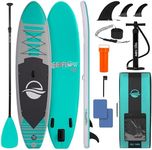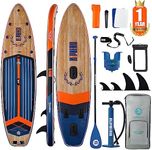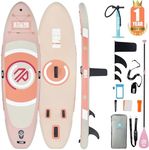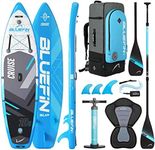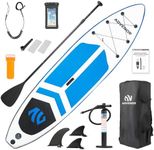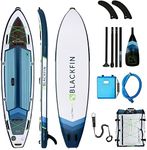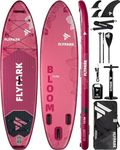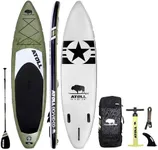Buying Guide for the Best Paddle Boards For Beginners
Choosing your first paddle board can be exciting but a bit overwhelming with all the options out there. The key is to focus on what will make your first experiences safe, fun, and easy to learn. Think about where you’ll use the board (calm lakes, rivers, or the ocean), how you’ll transport and store it, and your own comfort and confidence on the water. By understanding the main features of paddle boards, you’ll be able to pick one that matches your needs and helps you enjoy your time paddling.Board TypePaddle boards come in different types such as all-around, touring, and racing boards. For beginners, all-around boards are usually the best choice because they are designed to be stable and versatile, making them suitable for a variety of water conditions. Touring and racing boards are longer and narrower, built for speed and distance, but can be less stable and harder to balance on if you’re just starting out. If you’re new to paddle boarding, look for an all-around board to help you build confidence and skills.
Board LengthThe length of a paddle board affects how it handles on the water. Shorter boards (under 10 feet) are easier to turn and maneuver, making them good for kids or smaller paddlers, but they can be less stable. Medium-length boards (10 to 12 feet) offer a good balance of stability and maneuverability, which is ideal for most beginners. Longer boards (over 12 feet) are faster and track straighter, but they can be harder to control for new paddlers. Most beginners will feel comfortable on a board between 10 and 11 feet long.
Board WidthWidth is a key factor in how stable a paddle board feels. Wider boards (32 inches or more) provide more stability, which is great for beginners, people with a higher center of gravity, or those who want to do activities like yoga on the board. Narrower boards (under 30 inches) are faster and easier to paddle in a straight line, but they can feel tippy if you’re not used to balancing. If you’re just starting out, look for a board that’s at least 32 inches wide to help you stay steady.
Board ThicknessThickness affects both the board’s buoyancy and how rigid it feels under your feet. Thicker boards (around 5 to 6 inches) float better and can support more weight, making them a good choice for beginners, heavier paddlers, or those who want to bring a child or pet along. Thinner boards (under 5 inches) sit lower in the water and can feel less stable, especially for new paddlers. For most beginners, a board that’s 5 to 6 inches thick will provide the right mix of stability and support.
Board Material (Inflatable vs. Solid)Paddle boards are made as either inflatable or solid (hard) boards. Inflatable boards are lightweight, easy to transport and store, and are generally more forgiving if you fall or bump into things. Solid boards are usually more rigid and can offer better performance, but they are heavier and require more storage space. If you have limited storage or want to travel with your board, an inflatable is a great choice. If you want a more traditional feel and have space to store it, a solid board might be right for you.
Weight CapacityEvery paddle board has a recommended weight limit, which includes your body weight plus any gear or passengers. If you exceed this limit, the board will sit lower in the water and feel less stable. When choosing a board, make sure its weight capacity is higher than your own weight plus anything else you plan to bring along. This will help you stay comfortable and safe on the water.
Fin SetupFins help your paddle board track straight and provide stability. Most beginner boards come with a single large fin or a three-fin setup (one large center fin and two smaller side fins). A single fin is simple and works well for flat water, while three fins can offer more control and stability, especially in choppy water. For most beginners, either setup will work, but if you plan to paddle in different conditions, a three-fin setup can give you more versatility.



